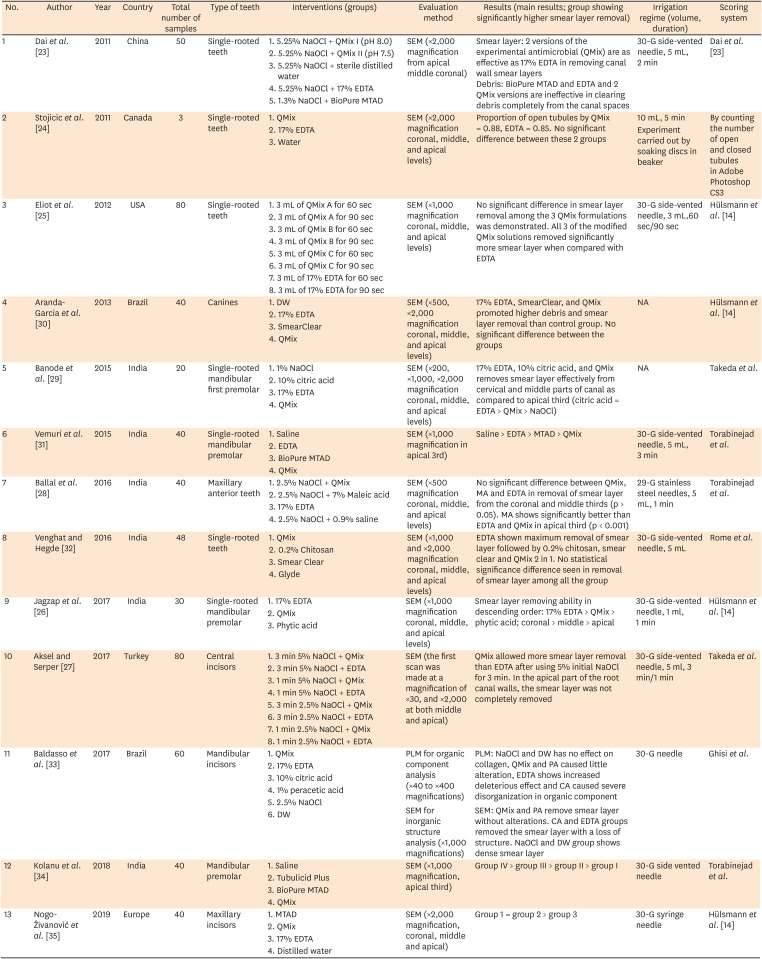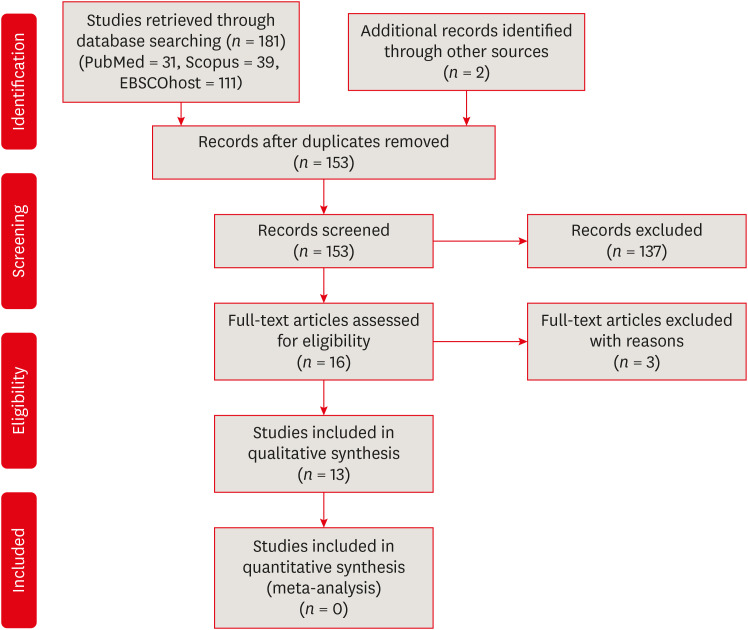1. Vieira AR, Siqueira JF Jr, Ricucci D, Lopes WS. Dentinal tubule infection as the cause of recurrent disease and late endodontic treatment failure: a case report. J Endod. 2012; 38:250–254. PMID:
22244647.

2. Nair PN, Sjögren U, Krey G, Kahnberg KE, Sundqvist G. Intraradicular bacteria and fungi in root-filled, asymptomatic human teeth with therapy-resistant periapical lesions: a long-term light and electron microscopic follow-up study. J Endod. 1990; 16:580–588. PMID:
2094761.

3. Gutmann J, Lovdahl P. Problem solving in endodontics. 5th ed. Maryland Heights (MO): Elsevier Mosby;2011.
4. Sen BH, Wesselink PR, Türkün M. The smear layer: a phenomenon in root canal therapy. Int Endod J. 1995; 28:141–148. PMID:
8626198.

5. Mader CL, Baumgartner JC, Peters DD. Scanning electron microscopic investigation of the smeared layer on root canal walls. J Endod. 1984; 10:477–483. PMID:
6593410.

6. Convissar R. Principles and practice of laser dentistry. London: Elsevier Health Sciences;2010. p. 223.
7. Yang G, Wu H, Zheng Y, Zhang H, Li H, Zhou X. Scanning electron microscopic evaluation of debris and smear layer remaining following use of ProTaper and Hero Shaper instruments in combination with NaOCl and EDTA irrigation. Oral Surg Oral Med Oral Pathol Oral Radiol Endod. 2008; 106:e63–e71. PMID:
18701325.

8. Wang Z, Shen Y, Haapasalo M. Effect of smear layer against disinfection protocols on
Enterococcus faecalis-infected dentin. J Endod. 2013; 39:1395–1400. PMID:
24139261.
9. Meryon SD, Brook AM. Penetration of dentine by three oral bacteria
in vitro and their associated cytotoxicity. Int Endod J. 1990; 23:196–202. PMID:
2098336.
10. Pintor AV, Dos Santos MR, Ferreira DM, Barcelos R, Primo LG, Maia LC. Does smear layer removal influence root canal therapy outcome? a systematic review. J Clin Pediatr Dent. 2016; 40:1–7. PMID:
26696099.

11. Zehnder M. Root canal irrigants. J Endod. 2006; 32:389–398. PMID:
16631834.

12. Weber CD, McClanahan SB, Miller GA, Diener-West M, Johnson JD. The effect of passive ultrasonic activation of 2% chlorhexidine or 5.25% sodium hypochlorite irrigant on residual antimicrobial activity in root canals. J Endod. 2003; 29:562–564. PMID:
14503827.

13. Johal S, Baumgartner JC, Marshall JG. Comparison of the antimicrobial efficacy of 1.3% NaOCl/BioPure MTAD to 5.25% NaOCl/15% EDTA for root canal irrigation. J Endod. 2007; 33:48–51. PMID:
17185130.
14. Hülsmann M, Heckendorff M, Lennon A. Chelating agents in root canal treatment: mode of action and indications for their use. Int Endod J. 2003; 36:810–830. PMID:
14641420.

15. Vallabhaneni K, Kakarla P, Avula SS, Reddy NV, Gowd MP, Vardhan KR. Comparative analyses of smear layer removal using four different irrigant solutions in the primary root canals - a scanning electron microscopic study. J Clin Diagn Res. 2017; 11:ZC64–ZC67.

16. Drake DR, Wiemann AH, Rivera EM, Walton RE. Bacterial retention in canal walls
in vitro: effect of smear layer. J Endod. 1994; 20:78–82. PMID:
8006570.
17. Haapasalo M, Orstavik D.
In vitro infection and disinfection of dentinal tubules. J Dent Res. 1987; 66:1375–1379. PMID:
3114347.
18. Jose J, Krishnamma S, Peedikayil F, Aman S, Tomy N, Mariodan JP. Comparative evaluation of antimicrobial activity of QMix, 2.5% sodium hypochlorite, 2% chlorhexidine, guava leaf extract and aloevera extract against Enterococcus faecalis and candida albicans - an in-vitro study. J Clin Diagn Res. 2016; 10:ZC20–ZC23.
19. Siqueira JF Jr, Rôças IN. Optimising single-visit disinfection with supplementary approaches: a quest for predictability. Aust Endod J. 2011; 37:92–98. PMID:
22117714.
20. Goldman LB, Goldman M, Kronman JH, Lin PS. The efficacy of several irrigating solutions for endodontics: a scanning electron microscopic study. Oral Surg Oral Med Oral Pathol. 1981; 52:197–204. PMID:
6791081.

21. Yamada RS, Armas A, Goldman M, Lin PS. A scanning electron microscopic comparison of a high volume final flush with several irrigating solutions: part 3. J Endod. 1983; 9:137–142. PMID:
6406635.

22. Goldman M, Goldman LB, Cavaleri R, Bogis J, Lin PS. The efficacy of several endodontic irrigating solutions: a scanning electron microscopic study: part 2. J Endod. 1982; 8:487–492. PMID:
6816890.

23. Dai L, Khechen K, Khan S, Gillen B, Loushine BA, Wimmer CE, Gutmann JL, Pashley D, Tay FR. The effect of QMix, an experimental antibacterial root canal irrigant, on removal of canal wall smear layer and debris. J Endod. 2011; 37:80–84. PMID:
21146083.

24. Stojicic S, Shen Y, Qian W, Johnson B, Haapasalo M. Antibacterial and smear layer removal ability of a novel irrigant, QMiX. Int Endod J. 2012; 45:363–371. PMID:
23134158.

25. Eliot C, Hatton JF, Stewart GP, Hildebolt CF, Jane Gillespie M, Gutmann JL. The effect of the irrigant QMix on removal of canal wall smear layer: an
ex vivo study. Odontology. 2014; 102:232–240. PMID:
23334869.
26. Jagzap JB, Patil SS, Gade VJ, Chandhok DJ, Upagade MA, Thakur DA. Effectiveness of three different irrigants - 17% ethylenediaminetetraacetic acid, Q-MIX, and phytic acid in smear layer removal: a comparative scanning electron microscope study. Contemp Clin Dent. 2017; 8:459–463. PMID:
29042735.

27. Aksel H, Serper A. Concentration and time-dependent effect of initial sodium hypochlorite on the ability of QMix and ethylenediaminetetraacetic acid to remove smear layer. J Conserv Dent. 2017; 20:185–189. PMID:
29279623.

28. Ballal NV, Jain I, Tay FR. Evaluation of the smear layer removal and decalcification effect of QMix, maleic acid and EDTA on root canal dentine. J Dent. 2016; 51:62–68. PMID:
27287285.

29. Banode AM, Gade V, Patil S, Gade J, Chandhok D, Sinkar R. Comparative scanning electron microscopy evaluation of smear layer removal with 17% ethylenediaminetetraacetic acid, 10% citric acid and newer irrigant QMix: in vitro study. Indian J Oral Health Res. 2015; 1:56–61.
30. Aranda-Garcia AJ, Kuga MC, Vitorino KR, Chávez-Andrade GM, Duarte MA, Bonetti-Filho I, Faria G, Só MV. Effect of the root canal final rinse protocols on the debris and smear layer removal and on the push-out strength of an epoxy-based sealer. Microsc Res Tech. 2013; 76:533–537. PMID:
23440741.

31. Vemuri S, Kolanu SK, Varri S, Pabbati RK, Penumaka R, Bolla N. Effect of different final irrigating solutions on smear layer removal in apical third of root canal: a scanning electron microscope study. J Conserv Dent. 2016; 19:87–90. PMID:
26957801.

32. Venghat S, Hegde MN. Comparative evaluation of smear layer removal efficacy using QMix 2in1, chitosan, smear clear and Glyde. Br J Med Med Res. 2016; 13:1–8.

33. Baldasso FE, Cardoso LR, Silva VD, Morgental RD, Kopper PM. Evaluation of the effect of four final irrigation protocols on root canal dentin components by polarized light microscopy and scanning electron microscopy. Microsc Res Tech. 2017; 80:1337–1343. PMID:
28925588.

34. Kolanu SK, Patnana AK, Nagesh B, Vaaka PHD, Polineni S. Scanning electron microscopic evaluation of smear layer removal ability of novel irrigant QMix compared with others at apical third of the root. World J Dent. 2018; 9:220–224.

35. Nogo-Živanović D, Kanjevac T, Bjelović L, Ristić V, Tanasković I. The effect of final irrigation with MTAD, QMix, and EDTA on smear layer removal and mineral content of root canal dentin. Microsc Res Tech. 2019; 82:923–930. PMID:
30786090.

36. Giardino L, Andrade FB, Beltrami R. Antimicrobial effect and surface tension of some chelating solutions with added surfactants. Braz Dent J. 2016; 27:584–588. PMID:
27982238.

37. Elnaghy AM. Effect of QMix irrigant on bond strength of glass fibre posts to root dentine. Int Endod J. 2014; 47:280–289. PMID:
23829648.

38. DiVito E, Peters OA, Olivi G. Effectiveness of the erbium:YAG laser and new design radial and stripped tips in removing the smear layer after root canal instrumentation. Lasers Med Sci. 2012; 27:273–280. PMID:
21120568.

39. Ahmad M, Pitt Ford TJ, Crum LA. Ultrasonic debridement of root canals: acoustic streaming and its possible role. J Endod. 1987; 13:490–499. PMID:
3482226.

40. Gulabivala K, Patel B, Evans G, Ng YL. Effects of mechanical and chemical procedures on root canal surfaces. Endod Topics. 2005; 10:103–122.

41. Raut AW, Mantri V, Palekar A, Gadodia R, Kala S, Raut RA. Comparative analysis of cleaning ability of three nickel-titanium rotary systems: ProTaper universal, K3 and Mtwo: an
in vitro scanning electron microscopic study. Niger Postgrad Med J. 2016; 23:221–226. PMID:
28000644.
42. Senia ES, Marshall FJ, Rosen S. The solvent action of sodium hypochlorite on pulp tissue of extracted teeth. Oral Surg Oral Med Oral Pathol. 1971; 31:96–103. PMID:
5275511.

43. de Gregorio C, Estevez R, Cisneros R, Heilborn C, Cohenca N. Effect of EDTA, sonic, and ultrasonic activation on the penetration of sodium hypochlorite into simulated lateral canals: an
in vitro study. J Endod. 2009; 35:891–895. PMID:
19482193.
44. de Gregorio C, Estevez R, Cisneros R, Paranjpe A, Cohenca N. Efficacy of different irrigation and activation systems on the penetration of sodium hypochlorite into simulated lateral canals and up to working length: an
in vitro study. J Endod. 2010; 36:1216–1221. PMID:
20630302.
45. Chow TW. Mechanical effectiveness of root canal irrigation. J Endod. 1983; 9:475–479. PMID:
6586975.

46. Arslan D, Guneser MB, Dincer AN, Kustarci A, Er K, Siso SH. Comparison of smear layer removal ability of QMix with different activation techniques. J Endod. 2016; 42:1279–1285. PMID:
27287613.

47. Niu LN, Luo XJ, Li GH, Bortoluzzi EA, Mao J, Chen JH, Gutmann JL, Pashley DH, Tay FR. Effects of different sonic activation protocols on debridement efficacy in teeth with single-rooted canals. J Dent. 2014; 42:1001–1009. PMID:
24878251.

48. Montero-Miralles P, Estévez-Luaña R, DeGregorio-González C, Valencia-dePablo O, Jaramillo DE, Cisneros-Cabello R. Effectiveness of Nd:YAG Laser on the elimination of debris and Smear Layer. A comparative study with two different irrigation solution: EDTA and QMix® in addition to NaOCl. J Clin Exp Dent. 2018; 10:e70–e74. PMID:
29670719.

49. Koçak S, Bağcı N, Çiçek E, Türker SA, Can Sağlam B, Koçak MM. Influence of passive ultrasonic irrigation on the efficiency of various irrigation solutions in removing smear layer: a scanning electron microscope study. Microsc Res Tech. 2017; 80:537–542. PMID:
28112855.

50. Prado MC, Leal F, Gusman H, Simão RA, Prado M. Effects of auxiliary device use on smear layer removal. J Oral Sci. 2016; 58:561–567. PMID:
28025441.

51. Prado MC, Leal F, Simão RA, Gusman H, do Prado M. The use of auxiliary devices during irrigation to increase the cleaning ability of a chelating agent. Restor Dent Endod. 2017; 42:105–110. PMID:
28503475.

52. Souza MA, Hoffmann IP, Menchik VHS, Zandoná J, Dias CT, Palhano HS, Bertol CD, Rossato-Grando LG. Influence of ultrasonic activation using different final irrigants on antimicrobial activity, smear layer removal and bond strength of filling material. Aust Endod J. 2019; 45:209–215. PMID:
30230647.

53. Prado M, Leal F, Simão R, Gusman H, Prado M. Effectiveness of a plastic endodontic file to remove smear layer in rotary or reciprocating motion. Int J Clin Dent. 2017; 10:143–151.
54. Marques AC, Aguiar BA, Frota LM, Guimarães BM, Vivacqua-Gomes N, Vivan RR, Duarte MA, de Vasconcelos BC. Evaluation of influence of widening apical preparation of root canals on efficiency of ethylenediaminetetraacetic acid agitation protocols: study by scanning electron microscopy. J Contemp Dent Pract. 2018; 19:1087–1094. PMID:
30287709.

55. Peters OA, Barbakow F. Effects of irrigation on debris and smear layer on canal walls prepared by two rotary techniques: a scanning electron microscopic study. J Endod. 2000; 26:6–10. PMID:
11194369.

56. Brunson M, Heilborn C, Johnson DJ, Cohenca N. Effect of apical preparation size and preparation taper on irrigant volume delivered by using negative pressure irrigation system. J Endod. 2010; 36:721–724. PMID:
20307751.

57. Arya A, Bali D, Grewal MS. Histological analysis of cleaning efficacy of hand and rotary instruments in the apical third of the root canal: a comparative study. J Conserv Dent. 2011; 14:237–240. PMID:
22025825.

58. Poggio C, Dagna A, Chiesa M, Scribante A, Beltrami R, Colombo M. Effects of NiTi rotary and reciprocating instruments on debris and smear layer scores: an SEM evaluation. J Appl Biomater Funct Mater. 2014; 12:256–262. PMID:
24425380.

59. Baxter S, Beck F, Hülsmann M. Root canal preparation using S5, Mtwo, and ProTaper Universal nickel-titanium systems: a comparative
ex-vivo study. Quintessence Int. 2019; 50:358–368. PMID:
30957111.
60. Wadhwani KK, Tikku AP, Chandra A, Shakya VK. A comparative evaluation of smear layer removal using two rotary instrument systems with ethylenediaminetetraacetic acid in different states: a SEM study. Indian J Dent Res. 2011; 22:10–15. PMID:
21525670.






 PDF
PDF Citation
Citation Print
Print





 XML Download
XML Download